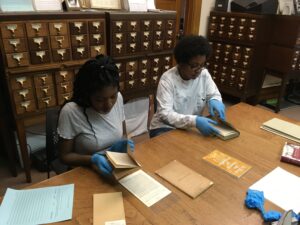
In spring 2020, the Black Heritage Project at the Liberal Arts Action Lab (LAAL) took on the task of investigating and telling the story of the historic Talcott Street Congregational Church. The church was the first Black church and school in Hartford and was home to prominent abolitionists, notably the Reverend James W.C. Pennington, who led the church in the 1840s and 50s. I participated in the project as a student at Capital Community College (CCC). The original site of the church sits right across the street from Capital’s parking lot. As students, we walk near this place on our way to classes, yet most of us don’t know anything about it. The LAAL Black Heritage Project produced an online exhibit that served as the basis for a successful National Endowment for the Humanities grant application, which is making Hartford’s Black history accessible to students both at Capital and in local K-12 schools.
Our goal was to research the Talcott Street Church, find a way to memorialize the legacy of important figures and events, and to include Capital Community College and the Hartford community in our work. Our community partners, Hartford Heritage Project, Hartford History Center, and the members of the Faith Congregational Church, the Talcott Street Church’s current incarnation, hoped to spread knowledge of Talcott Street Church.
My group began with a background literature review about the Church. Then we visited the Harriet Beecher Stowe Center, The Old State House, Hartford Public Library’s Hartford History Center, and the Connecticut Historical Society to gather information. We also visited Faith Congregational Church and met their history committee. After going to these places, we used our information to write a paper, a proposal, and to create an online exhibit. This process all happened during the height of the pandemic of 2020. Our in-person meetings were turned into Zoom meetings. We made a texting group chat to keep up with each other and accomplished so much despite being in lock down.
As I learned about the church and its leaders, I was surprised that I didn’t learn this local history in the school systems; both public and charter. Growing up in Hartford, I went to school in both predominantly White and Black schools. During my time in school, my teachers often would not talk about local Black figures and events unless it was Black History Month. Even then, they would only discuss the same prominent leaders and figures. After this project, there is more material ready for the public and accessible to anyone who needs it.
The fact about the church that sticks with me the most is that Talcott Street Church was a site on the Underground Railroad. The church members would take in Black people running away and provide them food, shelter and education. The congregation would also fundraise for ships to West Africa and some congregation members helped with the Amistad trial. The church went to the length of sheltering the people during the trial and raising funds for the trip back home.

Building on our LAAL project, in 2021 Capital Community College received a $150,000 grant from the National Endowment for the Humanities to continue to support curriculum development and a public exhibition on this important history. On September 17th, 2022, Capital Community College opened the exhibit based on the Talcott Street Congregational church and historical events within the church’s timeline. The funding also established an annual public lecture on race in America named after Reverend Pennington. The first Pennington Lecture was held in April 2022 with Dr. Sarah Lewis as the keynote speaker. Lewis, an Associate Professor at Harvard University, gave a talk titled “Vision and Justice.” Christopher Webber also spoke on his biography of Pennington. The 2023 lecture will be on February 9, 2023 and will feature Jelani Cobb, Dean of Journalism at Columbia University and New Yorker staff writer. The lectures are free and open to the public. The city of Hartford has a powerful and thriving Black community that can be supported by better understanding the history of the powerful figures who made up the Talcott Street Congregational Church. Three ways to get involved with this project are:
- Attend a free public lecture. Find the schedule of events at: https://www.capitalcc.edu/hhp/
- Visit the online exhibit at https://action-lab.org/black-heritage or the permanent in-person exhibit at Capital Community College. The exhibit is located at 950 Main Street and is open during College hours.
- Visit the Harriet Beecher Stowe House, The Old State House, and the Hartford Public Library to learn more about the history of Black leaders and activism in Hartford, including the history of the Talcott Street Church
This project matters to me because this church was important to the Black community of Hartford. With the social climate of Black Lives Matter and police brutality, the history of the Talcott Street Congregational Church can inspire Black leaders within Hartford and be a beacon of strength to the community.
